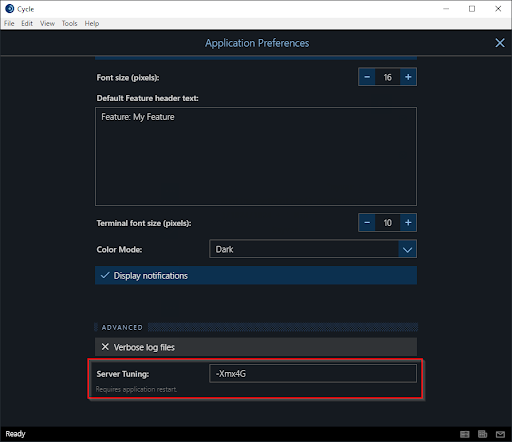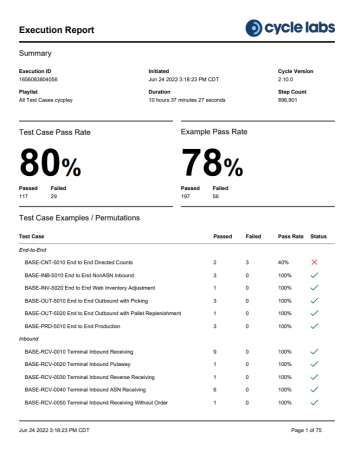Custom Web Reports
When generating web reports, you can now customize your own, using Jasper Reports. To create a custom report, download Jaspersoft Studio Community Edition. A sample report template has been included for you and is included in the Reports folder of your project. The sample template is BasicCycleReport.jrxml. An excellent resource to get started with Jasper Reports is the JasperReports Library Ultimate Guide.
HEAP Size and Reporting
The memory available to the reporting engine at the end of the test can be adjusted by setting the Java Max Heap (-Xmx) argument when the JVM is started. Depending on how Cycle is run, this is accomplished one of two ways:
-
Cycle UI - At the bottom of the Application Preferences (Edit → Preferences), there is a setting labeled "Server Tuning". The JVM arguments can be entered into this field and the changes will take effect the next time Cycle UI is opened:

-
Cycle CLI - cycle-cli reads the contents of an environment variable called JETVMPROP and passes its contents to the JVM when it starts the Cycle engine. See example below in PowerShell:
Recommended HEAP sizes for Cycle Tests:

Example Custom Report

Test Header Information
select cycle_test_execution.execution_id,
cycle_test_execution.cycle_user,
cycle_test_execution.execution_start_ts,
TRIM(BOTH '"' FROM cycle_test_execution.INVOKER) AS INVOKER,
cycle_execution_results.name as test_name,
cycle_execution_results.file_uri as test_file
from cycle_test_execution
join cycle_execution_results
on cycle_execution_results.execution_id = cycle_test_execution.execution_id
and cycle_execution_results.parent_node_id is null
where cycle_test_execution.execution_id = $P{execution_id}
Feature Summary Information
select cycle_execution_results.name,
cycle_execution_results.node_id,
cycle_execution_results.status,
cycle_execution_results.start_time,
cycle_execution_results.end_time,
EXTRACT(EPOCH FROM cycle_execution_results.end_time) - EXTRACT(EPOCH FROM cycle_execution_results.start_time) as duration,
CHAR_LENGTH(cycle_execution_results.node_id) - CHAR_LENGTH(REPLACE(cycle_execution_results.node_id, '.', '')) as depth
from cycle_test_execution
join cycle_execution_results
on cycle_execution_results.execution_id = cycle_test_execution.execution_id
where cycle_test_execution.execution_id = $P{execution_id}
and (cycle_execution_results.block_type in ('Scenario:', 'InnerScenario') or cycle_execution_results.node_type = 'Feature')
order by cycle_execution_results.node_sequence
Feature Detail Information
select cycle_execution_results.name,
cycle_execution_results.node_id,
cycle_execution_results.parent_node_id,
cycle_execution_results.node_type,
cycle_execution_results.status,
cycle_execution_results.start_time,
cycle_execution_results.end_time,
EXTRACT(EPOCH FROM cycle_execution_results.end_time) - EXTRACT(EPOCH FROM cycle_execution_results.start_time) as duration,
CHAR_LENGTH(cycle_execution_results.node_id) - CHAR_LENGTH(REPLACE(cycle_execution_results.node_id, '.', '')) as depth,
cycle_execution_results.message,
cycle_execution_results.error_message,
cycle_terminal_screens.screen,
cycle_image.id as image_id,
cycle_image.image
from cycle_test_execution
join cycle_execution_results
on cycle_execution_results.execution_id = cycle_test_execution.execution_id
left join cycle_terminal_screens
on cycle_terminal_screens.execution_id = cycle_execution_results.execution_id
and cycle_terminal_screens.node_id = cycle_execution_results.node_id
left join cycle_image_results
on cycle_image_results.execution_id = cycle_execution_results.execution_id
and cycle_image_results.node_id = cycle_execution_results.node_id
left join cycle_image
on cycle_image.id = cycle_image_results.screenshot_image_id
where cycle_test_execution.execution_id = $P{execution_id}
order by cycle_execution_results.node_sequence
Group Test Worker Header Information
select cycle_test_execution.execution_id,
cycle_execution_results.name as test_name,
cycle_execution_results.WORKER_NAME,
CYCLE_EXECUTION_RESULTS.NODE_ID
from cycle_test_execution
join cycle_execution_results
on cycle_execution_results.execution_id = cycle_test_execution.execution_id
and cycle_execution_results.parent_node_id is null
where cycle_test_execution.execution_id = $P{execution_id}
Alternative Group Test Worker Header Information
WITH recursive nodes(NODE_ID, PARENT_NODE_ID, EXECUTION_ID, group_name) AS
(
SELECT NODE_ID,
PARENT_NODE_ID,
execution_id,
name AS group_name,
NULL AS feature_name,
NAME,
NODE_SEQUENCE,
status,
NULL AS worker_name
FROM CYCLE_EXECUTION_RESULTS
WHERE EXECUTION_ID = $P{execution_id} AND PARENT_NODE_ID = '0-grouptest'
UNION ALL
SELECT child.NODE_ID,
child.PARENT_NODE_ID,
child.execution_id,
parent.group_name AS group_name,
child.name AS feature_name,
child.NAME,
child.NODE_SEQUENCE,
child.status,
child.worker_name
FROM CYCLE_EXECUTION_RESULTS as child
JOIN nodes as parent
on parent.execution_id = child.EXECUTION_ID
AND parent.node_id = child.PARENT_NODE_ID
WHERE child.EXECUTION_ID = $P{execution_id}
and child.node_type = 'Feature'
)
SELECT * FROM nodes WHERE worker_name is not null ORDER BY group_name, worker_name;
Group Test Worker Detail Information
WITH recursive nodes(NODE_ID, PARENT_NODE_ID, EXECUTION_ID) AS
(
SELECT NODE_ID, PARENT_NODE_ID, execution_id, NAME, NODE_SEQUENCE
FROM CYCLE_EXECUTION_RESULTS WHERE EXECUTION_ID = $P{execution_id} AND NODE_ID = $P{node_id}
UNION ALL
SELECT child.NODE_ID, child.PARENT_NODE_ID, child.execution_id, child.NAME, CHILD.NODE_SEQUENCE
FROM CYCLE_EXECUTION_RESULTS as child
JOIN nodes as parent on parent.node_id = child.PARENT_NODE_ID
WHERE child.EXECUTION_ID = $P{execution_id}
)
SELECT * FROM nodes ORDER BY NODE_SEQUENCE ;
Report Data Schema
The same schema used for the data store is now available for web reports. For detailed documentation of that schema, see the Data Store Reports section of the User Manual. The schema is documented under the JDBC Data store ERD subsection. A sample query that would include terminal screenshots and images is as follows.
SELECT (SELECT name FROM CYCLE_EXECUTION_RESULTS AS HEADER where HEADER.execution_id = CYCLE_TEST_EXECUTION.EXECUTION_ID AND HEADER.parent_node_id IS null) as TITLE,
(SELECT FILE_URI FROM CYCLE_EXECUTION_RESULTS AS HEADER where HEADER.execution_id = CYCLE_TEST_EXECUTION.EXECUTION_ID AND HEADER.parent_node_id IS null) as FILE_URI,
CYCLE_EXECUTION_RESULTS.NODE_ID,
REPLACE( REGEXP_REPLACE( CYCLE_EXECUTION_RESULTS.NODE_ID,'[^\\.]',''),'.',' ') || CYCLE_EXECUTION_RESULTS.NAME AS indent_name,
CYCLE_EXECUTION_RESULTS.NAME,
CYCLE_EXECUTION_RESULTS.STATUS,
FORMATDATETIME(CYCLE_EXECUTION_RESULTS.START_TIME,'HH:mm:ss.SSS') as START_TIME,
FORMATDATETIME(CYCLE_EXECUTION_RESULTS.END_TIME,'HH:mm:ss.SSS') as END_TIME,
CYCLE_TERMINAL_SCREENS.SCREEN as SCREEN,
CYCLE_IMAGE.IMAGE,
CYCLE_TEST_EXECUTION.EXECUTION_ID,
TRIM(BOTH '' FROM CYCLE_TEST_EXECUTION.INVOKER) AS APP,
replace(FORMATDATETIME(CYCLE_TEST_EXECUTION.EXECUTION_START_TS, 'yyyy-MM-dd HH:mm:ssZ'), ' ', '<br/>') as EXECUTION_START_TS
FROM CYCLE_TEST_EXECUTION
JOIN CYCLE_EXECUTION_RESULTS
ON CYCLE_TEST_EXECUTION.EXECUTION_ID = CYCLE_EXECUTION_RESULTS.EXECUTION_ID
LEFT JOIN CYCLE_TERMINAL_SCREENS
ON CYCLE_TERMINAL_SCREENS.EXECUTION_ID = CYCLE_EXECUTION_RESULTS.EXECUTION_ID
AND CYCLE_TERMINAL_SCREENS.NODE_ID = CYCLE_EXECUTION_RESULTS.NODE_ID
LEFT JOIN CYCLE_IMAGE_RESULTS
ON CYCLE_IMAGE_RESULTS.EXECUTION_ID = CYCLE_EXECUTION_RESULTS.EXECUTION_ID
AND CYCLE_IMAGE_RESULTS.NODE_ID = CYCLE_EXECUTION_RESULTS.NODE_ID
LEFT JOIN CYCLE_IMAGE
ON CYCLE_IMAGE.ID = CYCLE_IMAGE_RESULTS.SCREENSHOT_IMAGE_ID
WHERE CYCLE_TEST_EXECUTION.EXECUTION_ID = $P{execution_id}
ORDER BY CYCLE_EXECUTION_RESULTS.NODE_SEQUENCE ASC
When a web report is being generated, Cycle will provide Jasper with the JDBC connection and two parameters, execution_id
and SUBREPORT_ROOT. If you are not using any subreports, the only parameter you'll need to include in your query is P${execution_id}.
If you are utilizing a subreport, though Jaspersoft Studio will automatically find the other reports in your workspace, the
embedded Jasper report engine does not, and a full path to the subreport will be required. Since that's often going to be
not practical as the same Cycle project may be run on a variety of machines, Cycle will pass in a SUBREPORT_ROOT, which is
will be calculated as the parent directory of the main report. So if your subreport name is DetailReport.jasper, then the
expression in your main report for the location of the subreport would be $P{SUBREPORT_ROOT} + "DetailReport.jasper".
Note that the SUBREPORT_ROOT will include a trailing slash. So, for example, if your reports are in a directory with a path
of C:/Users/Cycle/Reports, the SUBREPORT_ROOT parameter passed to the main report will be C:/Users/Cycle/Reports/.
Once your custom report is ready to use, you will compile your .jrxml file into a .japser file. The .jasper file must be copied to a directory in your project, such as the Reports directory. In your project settings, under the Report Settings category, set the "Web Report Template" setting to "Custom". Then set the "Custom Web Report Template" setting to path of your .jasper file. The next test in your project that is configured to produce a web report will then use your new custom template rather than the standard template. To revert back to the standard template, simply set the "Web Report Template" setting to "Default"; you do not need to clear the "Custom Web Report Template" setting.
When running cyclecli, the keys for these settings are:
- LocalReportKey
- This setting controls whether the standard (default) template or a custom template should be used when generating web reports.
- Valid values are "Custom" or "Default"
- LocalReportCustomPathKey
- This setting defines the path for the .jasper file to be used when generating a custom web report.
- The path is relative to your project directory, e.g., "Reports/Simple_1.jasper"
- LocalReportOutputFormatKey
- This setting controls where the report output is HTML or PDF. Both the standard and custom reports can be output to either format.
- Valid values are "HTML" or "PDF"
The LocalReportCustomPathKey can be useful when running various types of tests in a CI/CD pipeline. For example, you may have one custom format you want to use for a simple terminal feature and a different custom format that you want to use in a test of a web application. Or you may want to provide more of a summary report format for a group test or playlist, rather than including every single step that was executed. Or perhaps you may want a custom format that focuses on failures rather than a full report of every step that was executed. Any such scenario can be handled with a custom report template.
Notes:
These reports are designed for a single test. The temporary database which houses the data is deleted when Cycle exits. For reports that include historical data or trends, the datastore functionality in Cycle would be more appropriate. The custom report functionality is provided to give users an easy way to customize their reports without having to worry about maintaining their own database outside of Cycle for the datastore.